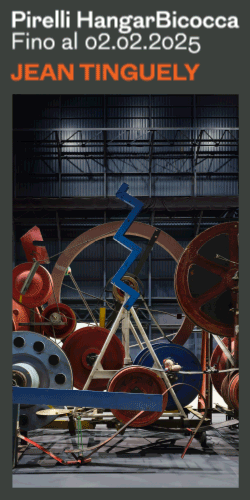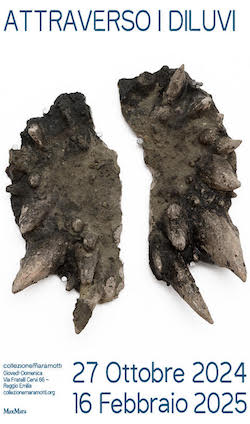

English version below
TOTEM è il titolo del nuovo progetto dell’artista Wallace Chan per il rinnovato Fondaco Marcello, a Venezia. Fino al 23 ottobre 2022, i visitatori potranno perdersi tra le travi di ferro e le teste in titanio che compongono l’installazione, una gigantesca costruzione di dieci metri smembrata all’interno del fondaco, in uno spazio buio, quasi ipogeo e mistico. Una musica dal carattere orientaleggiante mi accompagna alla scoperta di TOTEM, mentre Chan racconta del profondo valore simbolico – totemico appunto – che la sua operazione racchiude: simboli, natura e frammentarietà sono i caratteri che contraddistinguono l’installazione, un’ opera che permette allo spettatore di viaggiare con il corpo, la mente e lo spirito alla ricerca di unità e pace in un contesto disgregato e incomprensibile.
Veronica Pillon: TOTEM è il titolo della tua ultima ed inedita installazione, presentata al Fondaco Marcello in occasione della 59ª Biennale d’Arte. Di che cosa si tratta?
Wallace Chan: L’installazione doveva essere una scultura alta 10 metri. Per questo originariamente stavo cercando a Venezia un luogo adeguato in cui esporla. Quando sono arrivato all’aeroporto e ho visitato alcuni spazi in cui allestirla, ho deciso di (dis)-assembrarla nelle sale del Fondaco Marcello. Questo perché, nei due anni di pandemia, moltissime cose sono cambiate. Volevo trasmettere quest’idea di incertezza e di frammentazione attraverso la mia installazione, quindi ho pensato fosse più significativo allestire la scultura frammentata in vari pezzi. Ho poi realizzato un diagramma della scultura originaria – intera appunto – che ho posto alla fine del percorso, a simboleggiare la necessità di ricostruzione e incontro. E questo non può che essere possibile guardandoci dentro.
VP: A cosa si riferisce il termine “Totem”?
Wallace Chan: Ogni paese e ogni cultura ha i propri simboli, i totem appunto. Per me, il totem rappresenta il tentativo di mostrare ciò che non si vede e il potere delle cose che spesso non si comprendono. Totem è potere e speranza. Questo perché la speranza unisce e aiuta le persone a immaginare e a raggiungere qualcosa di più grande.
Il mio primo ricordo di un totem è legato alla mia infanzia, quando ho camminato in un tempio cinese per la prima volta. Qui ho trovato dei totem di creature fantastiche come dragoni o leoni, simboli degli dei e tentativo del fedele di connettersi con loro.
VP: Nel tuo lavoro ti riferisci quindi al Buddismo?
Wallace Chan: Sono stato anche un monaco, ma quello che ho capito è che è l’amore il fulcro di tutto. Amore che si rivolge a ogni cosa nell’universo. Amando tratti tutto con rispetto. Non ho di fatto una religione, ma tutti gli scritti che ho studiato mi hanno influenzato.

VP: Quali altri pensieri, esperienze o situazioni hanno influenzato la natura e lo sviluppo del tuo progetto?
Wallace Chan: Tutti i miei lavori sono influenzati dall’infanzia. Gli eventi del mio passato hanno influenzato la mia vita e la mia arte. Sono cresciuto con niente, la mia famiglia era povera e ho avuto un’educazione elementare. Ho imparato che la vita quotidiana è una lotta – dal cibo, al lavoro, alla casa ecc. – e questo mi ha portato a crescere con un grande senso di insicurezza. Allo stesso tempo ho imparato a lavorare sodo e ad affinare le mie qualità e competenze. Sono autodidatta, non ho avuto un insegnante. Ho provato vari materiali, ho visto mostre e parlato con molte persone, cercando di imparare qualcosa da ciascuno di loro. Non ho esitato di fronte alle sfide e le ho affrontate.
VP: Il tuo lavoro è una gigantesca scultura in titanio. Sei un artista multidisciplinare ma prediligi il titanio. Perché questa scelta così particolare?
Wallace Chan: Penso che ogni materiale abbia la sua personalità. Il titanio simboleggia l’eternità: vorrei infatti creare un’opera che mi sopravviva, per molte generazioni.
VP: Perché hai reso il Fondaco una stanza oscura e buia?
Wallace Chan: In realtà, il focus è la luce. I pezzi dell’installazione sono tutti illuminati da diverse sfumature di luce, dalla più fredda alla più calda. Il visitatore va incontro all’incertezza nella sua passeggiata tra i frammenti, non sapendo cosa troverà svoltando l’angolo. Deve esplorare e sperimentare. Inoltre, un’atmosfera come questa aiuta ad entrare a contatto con l’universo.
VP: Quindi tutti i nostri sensi sono coinvolti nell’esperienza.
Wallace Chan: Esatto! Nel buio siamo più consapevoli.
VP: Alcune parti dell’installazione sono delle facce con gli occhi chiusi. A cosa si riferiscono?
Wallace Chan: Quando ero un monaco, ho imparato che le figure buddiste in realtà non hanno gli occhi chiusi, perché un terzo dell’occhio rimane aperto. Questo perché un terzo dell’occhio guarda il paradiso, un terzo l’infermo e un terzo l’umano. Ma avendo un terzo dell’occhio aperto, cosa stiamo guardando veramente? Di nuovo, si parla di concentrazione e di sperimentazione. Per esempio, alcune parti dell’installazione sono nasi od orecchie: questo perché tutti abbiamo il naso o le orecchie, ma non ci pensiamo mai se non quando li usiamo o ci vediamo riflessi allo specchio. Voglio infondere l’idea che bisogna sempre essere consapevoli e attenti.



Interview with Wallace Chan | TOTEM – Fondaco Marcello, Venice
TOTEM is the title of the new project by Wallace Chan for the renovated Fondaco Marcello, in Venice. Until 23 October 2022, visitors will be able to get lost among the iron beams and titanium heads that form the installation, a gigantic ten-meter building dismembered inside the Fondaco, in a dark, almost hypogeum and mystical space. Oriental music accompanies me to the discovery of TOTEM, while Chan tells of the profound symbolic value – totemic in fact – that his operation contains: symbols, nature and fragmentation are the characters that distinguish the installation, a work that allows the viewer to travel with the body, mind and spirit in search of unity and peace in a disintegrated and incomprehensible context.
Veronica Pillon: Totem is the title of your latest installation exhibited at Fondaco Marcello for the 59th Biennale. What is it about?
Wallace Chan: It should be a 10 meters high sculpture, so I was originally looking for a proper place to exhibit this sculpture in Venice, but when I went to the airport and searched for sites to installed it, I decided to (dis)-assemble it in Fondaco Marcello. That is because, after two years of pandemic, a lot of things has changed. I want to transfer this atmosphere of uncertainty and fragmentation in my installation, so I thought it was more relevant to display sculpture’s fragmented pieces. Then, I realized a diagram of the entire sculpture – a diagram I put at the end of the exhibition – to signify the necessity of reconstruction and reunion. That is possible only by looking on ourselves.
VP: What does the term “Totem” refer to?
Wallace Chan: Every country and every culture has “totem”, symbols. For me, it represents people’s attempt to show what is hidden and the power of things they don’t understand rationally. Totem refers to power and hope. That is because hope connects and helps people imagine and achieve something greater and bigger. My earliest memory about totem is related to my childhood, when I have walked in a Chinese temple for the first time. Here there were totems of mythological creatures like dragons or lions which are the symbols of gods and the devotee’s attempt to connect with them.
VP: So do you refer to Buddhism in your work?
Wallace Chan: I was a monk, but I finally realized that love is what really matters. Love for everything in the universe. In this way you treat everything with respect. I don’t really have a religion, but all the writings I have studied have influenced me in my work.

VP: What experiences, thoughts or situations have influenced the nature and the development of this new exhibition project?
Wallace Chan: All my works are influenced by childhood too. The events of my childhood have a huge impact on my life and my art. I grew up with nothing, my family was poor and I didn’t go to school often. I learned that everyday life has its struggle – we are worried about food, work etc. – and I grew with a great sense of insecurity. At the same time, I learned to work hard and I improved my skills experiencing all these difficulties. I didn’t have a teacher, so I did it all by myself. I have tried different materials, seen many exhibitions and spoken with different people, attempting to learn something from each of them. I embraced every challenge.
VP: Your work is a huge titanium installation. You are a multidisciplinary artist, but titanium is one of your favorite materials. Why this choice?
Wallace Chan: I feel that each material has its own personality. In particular, titanium is the symbol of eternity: I wanted to realize a work that would last longer than my life.
VP: Why did you create a dark and obscure environment in the Fondaco?
Wallace Chan: In fact, it is all about the light. The fragmented pieces are enlightened by different shades of light, colder or warmer. Visitors discover uncertainty as they stroll among the fragmented pieces in the Fondaco, they don’t know what they might find around the corner. They need to explore and experience. An atmosphere like this help us to enter in contact with the universe, too.
VP: So all our senses and feelings are involved during our exploration.
Wallace Chan: Exactly ! In the dark we are more aware.
VP: Some fragmented pieces are faces with closed eyes. What do they represent?
Wallace Chan: When I was a monk, I learned that a Buddhist figure never has the eyes closed. In fact, one third of the eye is open. That is because one third of the eye looks to heaven, a third to hell and the last third to human. Having one third of the eye open, what are we really looking at? It is always about awareness and experience. For example, some pieces of Totem are noses or ears: that is because we all have noses or ears, but we never think to have them. We have to use them or to look in the mirror to notice them. I want to transmit the idea that we should be always aware.













